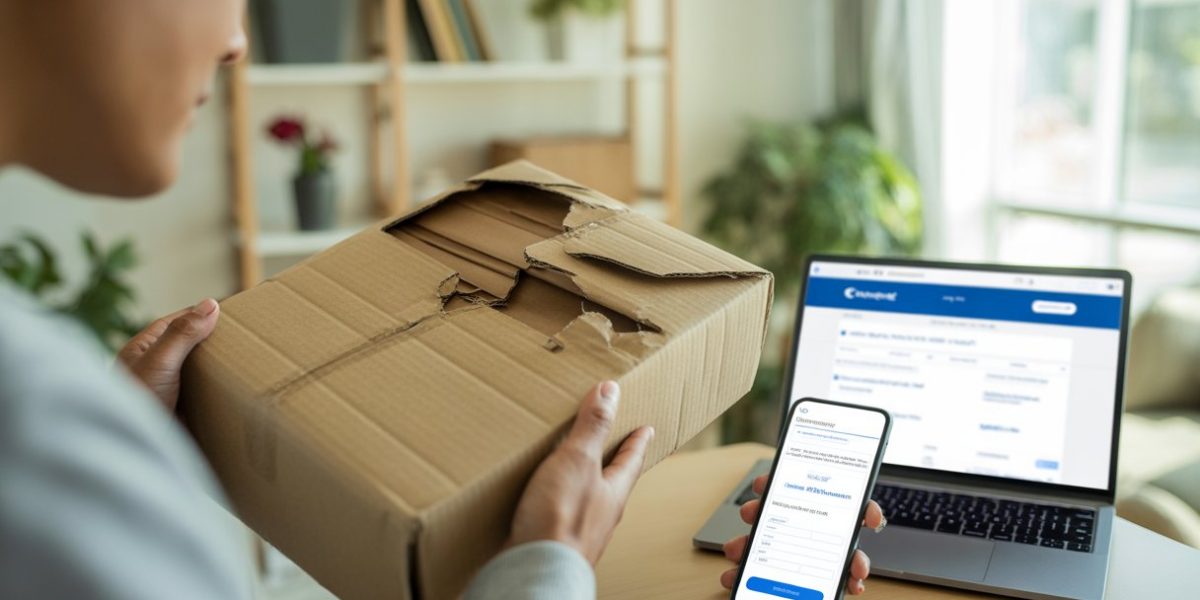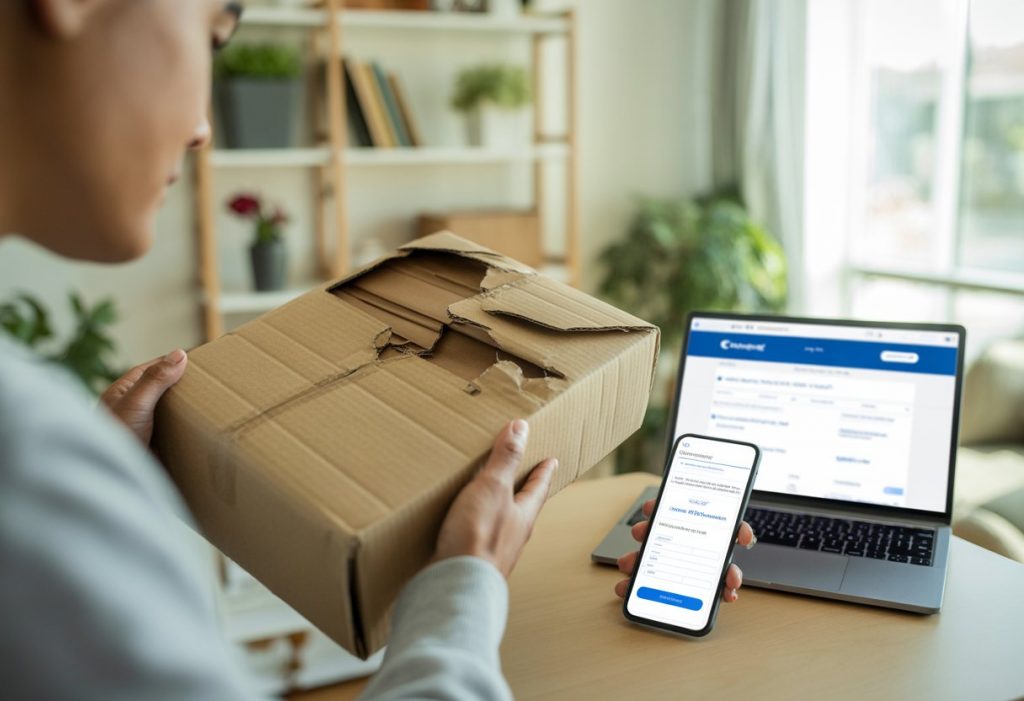Getting a damaged parcel can be frustrating, especially when you’ve been looking forward to your delivery. Whether the box is crushed, contents are broken, or the packaging is torn open, you have rights and options to sort out the problem.
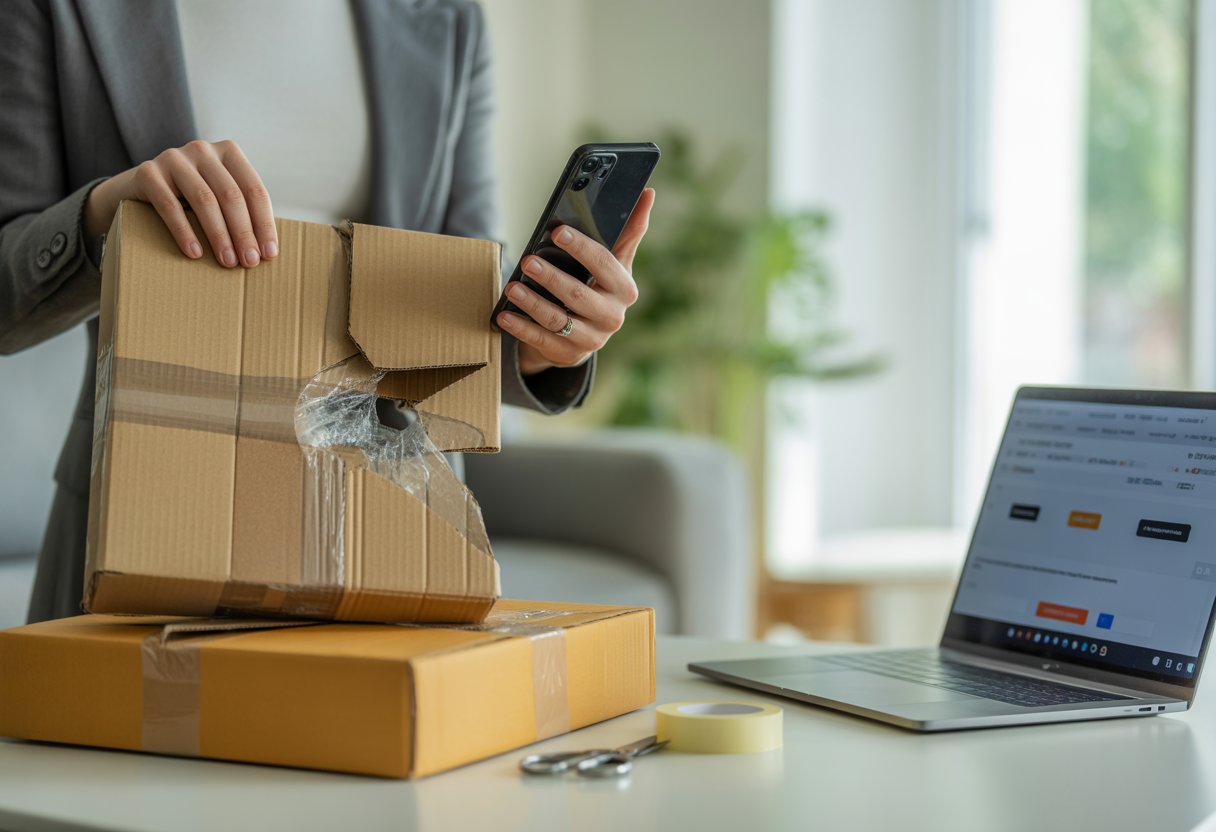
The retailer who sold you the item is responsible for fixing the situation, even if the courier damaged your parcel during delivery. This means you should contact the shop or website where you bought the item first, not the delivery company. Under UK consumer law, retailers must deal with damaged goods and provide solutions.
Knowing what steps to take can help you get a refund, replacement, or compensation quickly. From checking the damage properly to understanding your legal rights, there are clear actions you can take to resolve the issue and avoid being left out of pocket.
Assessing a Damaged Parcel Upon Arrival

Taking the right steps immediately after receiving a damaged parcel can determine whether you receive compensation. Quick documentation and careful handling of the damaged goods protect your rights as a consumer.
Immediate Steps to Take When You Receive a Damaged Parcel
The recipient should inspect the parcel carefully before signing any delivery confirmation. If damage is visible on the outside, they must note this on the delivery receipt or refuse the package entirely.
Do not move or alter the damaged goods once they arrive. The items must stay in exactly the same condition they were delivered in. This allows for a proper damage assessment later.
The recipient should contact the delivery company within 24 hours of receiving the damaged parcel. Most companies have strict time limits for reporting damage claims.
They should also inform the retailer or sender about the damage immediately. Even if the courier caused the damage, the complaint should go to the retailer first, not the delivery service.
Documenting Evidence of Parcel Damage
Taking clear photos is essential for any damage claim. The recipient should photograph the damaged packaging from multiple angles before opening it.
Once opened, they must photograph the damaged contents inside. These images serve as proof of the damage’s extent and condition upon arrival.
The following evidence should be collected:
- Photos of the outer packaging damage
- Images of damaged items inside
- Close-up shots showing specific damage details
- The delivery label and tracking information
- Any delivery receipts or notices
They should keep all original packaging materials. The delivery company may need to inspect these items as part of their investigation process.
Written notes about when and how the damage was discovered can support the claim. Include the delivery date, time, and courier details if available.
Understanding Delivery Acceptance and Signature Implications
Signing for a damaged parcel does not mean accepting responsibility for the damage. The signature only confirms that a package was delivered, not its condition.
Recipients have the right to refuse delivery if they notice obvious damage to the packaging. This refusal should be noted clearly on any delivery documents.
If they sign without noticing damage, they can still make a claim later. However, reporting damage after signing may require more evidence to prove the damage occurred during transit.
Digital signatures on delivery devices do not prevent damage claims. The same rules apply whether signing on paper or an electronic device.
Some delivery companies allow customers to add notes about package condition when signing. Using this feature helps create an immediate record of any concerns about the parcel’s state.
Understanding Your Consumer Rights with Damaged Parcels
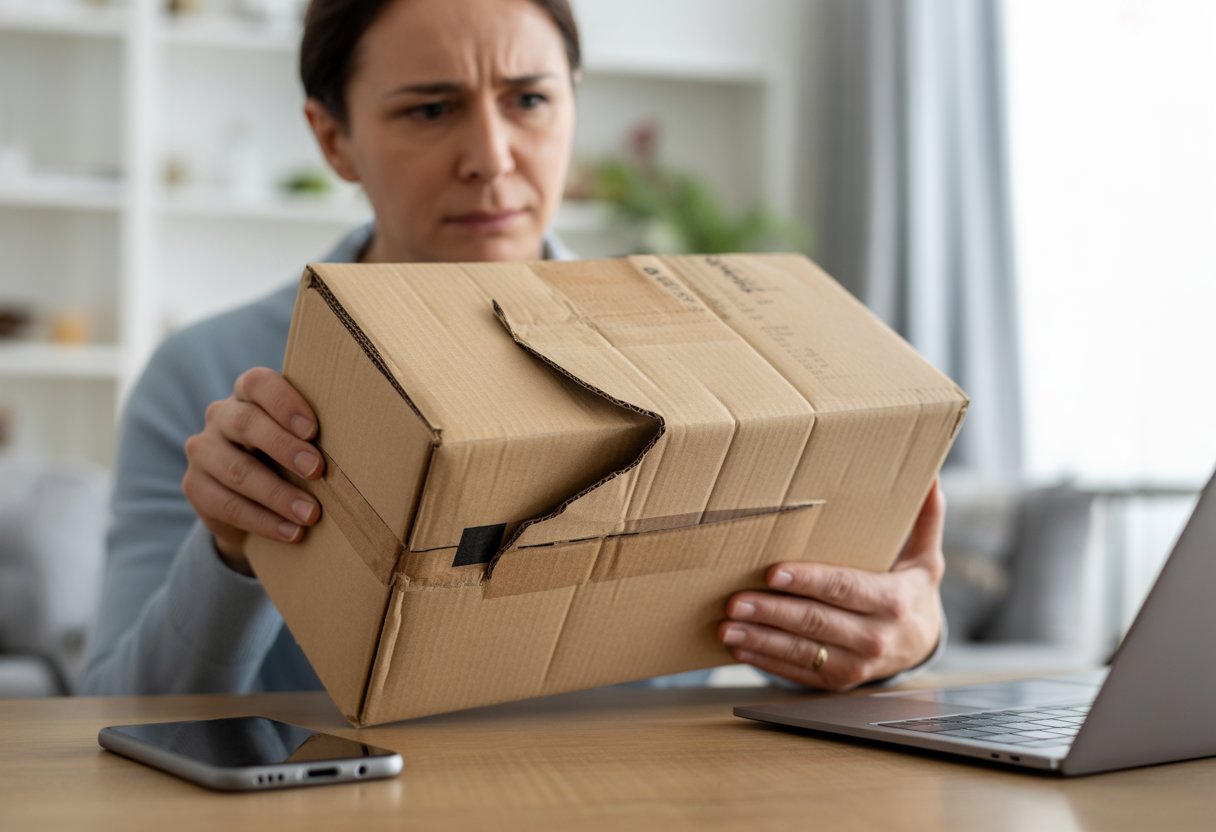
The Consumer Rights Act 2015 gives strong protection to consumers who receive damaged goods through post or delivery services. Retailers remain responsible for fixing problems even when courier companies cause the damage during transit.
Overview of the Consumer Rights Act 2015
The Consumer Rights Act 2015 replaced older consumer protection laws in the UK. It clearly states that goods must be of satisfactory quality, fit for purpose, and match their description.
When goods arrive damaged, they fail to meet these basic requirements. The Act gives consumers the right to reject faulty items or ask for repairs and replacements.
Key protections under the Act include:
- Right to reject damaged goods within 30 days
- Right to repair or replacement after 30 days
- Right to partial or full refund
- Protection against unfair contract terms
The law applies to all purchases made from traders, including online retailers. It covers both expensive and cheap items equally.
Consumers do not need to prove the damage happened during delivery. The retailer must show the goods were not damaged when they sent them.
Liability of Retailers Versus Couriers
Retailers remain liable for damaged goods even when courier companies cause the problem. Consumers should always contact the shop or website where they bought the item, not the delivery company.
This rule exists because consumers have a contract with the retailer, not the courier. The retailer chose which delivery service to use and must take responsibility for that choice.
The retailer’s responsibilities include:
- Investigating damage claims
- Arranging refunds or replacements
- Dealing with the courier company directly
The retailer can claim compensation from the courier company separately. This is a business matter between the retailer and delivery service that does not involve the consumer.
Some consumers mistakenly contact courier companies first. This often leads to delays and confusion about who should fix the problem.
The Right to Reject and Request Remedies
Consumers have specific rights when parcels arrive damaged. The type of remedy depends on when they report the damage and how serious it is.
Within the first 30 days:
- Full right to reject damaged goods
- Complete refund including delivery costs
- No need to accept repairs or replacements
After 30 days:
- Right to request repair or replacement first
- Right to refund if repair fails or takes too long
- Partial refund possible for minor damage
Retailers cannot charge restocking fees for genuinely damaged items. They must also pay return postage costs when goods arrive damaged.
The Consumer Rights Act sets clear time limits. Consumers have up to six years in England and Wales to make claims for damaged goods. In Scotland, the limit is five years.
Retailers cannot use contract terms to remove these legal rights. Any attempts to exclude liability for damaged goods are likely unfair and unenforceable.
How to Make a Claim or Complaint
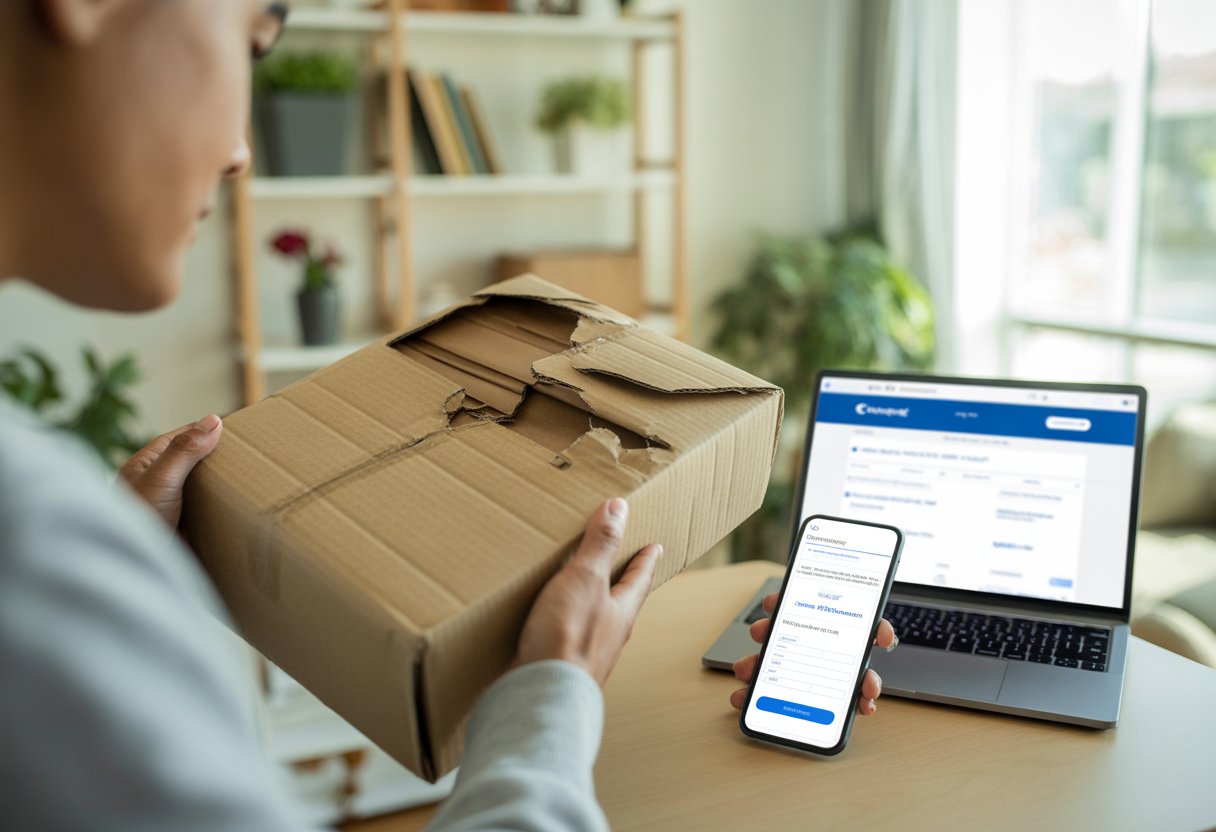
When a parcel arrives damaged, customers have clear rights to seek compensation through either the retailer or delivery company. The process involves gathering proper evidence, understanding available remedies like repair or replacement, and meeting specific time limits for claims.
Contacting the Retailer with Evidence
Customers should contact the retailer first when they receive a damaged parcel. The retailer remains responsible for ensuring goods arrive in proper condition, regardless of which courier delivered them.
Essential evidence to collect:
- Clear photographs showing the damaged packaging
- Photos of the damaged items inside
- Images of the original packaging labels
- Screenshots of the original order confirmation
Customers should take photos immediately upon opening the package. Multiple angles help demonstrate the extent of damage clearly.
The retailer cannot refuse responsibility by directing customers to the courier company. This practice violates consumer protection laws in the UK.
Contact should happen within 48 hours of delivery when possible. Quick reporting strengthens the claim and prevents disputes about when damage occurred.
Initiating a Return, Repair or Replacement
Retailers must offer suitable remedies for damaged goods. Customers can typically choose between repair, replacement, or a full refund depending on the circumstances.
Available options include:
- Repair – Suitable for items with minor fixable damage
- Replacement – New identical item sent at no extra cost
- Full refund – Complete money back including original delivery charges
The remedy must be provided at no additional cost to the customer. This includes return postage for sending back the damaged parcel.
Retailers should arrange collection of damaged items rather than expecting customers to return them. Heavy or fragile items especially warrant collection services.
If the first remedy fails, customers can request an alternative solution. A failed repair attempt allows customers to demand replacement or refund instead.
Time Limits and Required Documentation
Claims must be submitted within specific timeframes to remain valid. Most delivery companies accept claims up to 80 days after posting, though earlier submission improves success rates.
Required documentation typically includes:
- Proof of purchase or receipt
- Proof of posting (if customer sent the item)
- Evidence of damage through photographs
- Details of item contents and declared value
Royal Mail requires claims within 80 days of posting. Other courier services may have different limits, often between 14-30 days.
Customers should keep all original packaging until claims are resolved. Disposal of evidence can weaken or invalidate compensation requests.
Written communication creates better evidence trails than phone calls. Emails provide timestamps and record exactly what was reported to whom.
Refunds, Replacements, and Compensation Options
When a parcel arrives damaged, consumers have three main ways to get their money back or resolve the problem. The law gives buyers the right to claim a full refund, request a replacement or repair, or use their credit card protection to reverse the payment.
Claiming a Full Refund
Customers have the legal right to claim a full refund when goods arrive damaged. This applies whether they bought the item online or in a shop.
The seller must provide the refund, not the delivery company. Buyers should contact the retailer first with photos of the damaged item as proof.
Timeline for refunds:
- Online purchases: 14 days to return plus 14 days for refund
- Faulty goods: Reasonable time to inspect and return
- Full refund period: 30 days from purchase for major faults
Retailers cannot charge restocking fees for damaged goods. They must also refund the original delivery cost if the item arrived broken.
Some companies try to offer store credit instead of money back. Customers can refuse this and demand a cash refund for faulty items.
Requesting a Replacement or Repair
Buyers can choose between a refund, replacement, or repair when goods arrive damaged. The retailer must offer all three options under consumer protection laws.
A replacement means getting the exact same item in working condition. The seller pays for return postage and delivery of the new item.
Repairs must fix the problem completely and be done within a reasonable time. The company cannot charge for repairs to items that arrived damaged.
What retailers must provide:
- Free collection of damaged item
- No charge for replacement or repair
- Same model and specifications
- Working condition guarantee
If the replacement also arrives damaged, customers can demand a full refund instead. The law does not require buyers to accept multiple faulty items.
Understanding Chargeback and Credit Card Protection
Credit and debit card holders can use chargeback rights to get money back from their bank. This works when the retailer refuses to help or goes out of business.
Chargeback time limits:
- Debit cards: 120 days from purchase
- Credit cards: 120 days from knowing about the problem
- Section 75 protection: Up to 6 years for credit cards
Banks can reverse the payment and return money to the customer’s account. This process usually takes 2-8 weeks to complete.
Section 75 protection applies to credit card purchases between £100 and £30,000. The card company becomes equally responsible for faulty goods or services.
Customers should try resolving the issue with the seller first. Banks prefer to see evidence of contact with the retailer before processing chargeback claims.
What to Do About Parcel Theft and Stolen Deliveries
Parcel theft affects thousands of shoppers each year, with stolen parcels becoming more common as online shopping grows. Understanding how to spot theft, report it properly, and protect future deliveries can save time and money.
Recognising Parcel Theft and Stolen Parcels
Most parcel theft happens when packages are left unattended at doorsteps or in communal areas. Thieves often follow delivery vans or watch for packages left outside homes.
Common signs of parcel theft include:
- Tracking shows “delivered” but no package arrived
- Neighbours didn’t receive the parcel by mistake
- Package disappeared within hours of delivery
- Torn packaging or empty boxes found nearby
Check with neighbours first before assuming theft has occurred. Delivery drivers sometimes leave packages in safe places like behind bins or with nearby residents.
Contact the delivery company to confirm the exact delivery location. They can provide photos or detailed notes about where the driver left the package.
Some delivery companies mark packages as delivered before they actually arrive. Wait 24 hours before reporting a package as stolen.
Reporting a Stolen Parcel and Notifying Authorities
The retailer, not the delivery company, is responsible for stolen parcels under UK consumer law. Contact the seller immediately when a parcel goes missing.
Steps to report stolen parcels:
- Contact the retailer within 14 days
- Provide order details and tracking information
- Explain when and how the theft occurred
- Request a replacement or full refund
Most retailers will offer a replacement or refund without question. They have insurance to cover stolen deliveries and will investigate with their delivery company.
Report the theft to local police if the package was valuable. Get a crime reference number to support insurance claims or disputes with retailers.
Keep all communication with the retailer in writing. Use email rather than phone calls to create a paper trail of your complaint.
Steps to Prevent Parcel Theft
Delivery location options:
- Use workplace addresses during business hours
- Choose collection points like post offices or shops
- Install secure parcel boxes outside your home
- Arrange specific delivery time slots when you’re home
Request signature confirmation for valuable items. This ensures packages aren’t left unattended and creates proof of proper delivery.
Security measures include:
- Install doorbell cameras or security systems
- Ask trusted neighbours to collect packages
- Use Amazon lockers or similar secure pickup points
- Schedule deliveries for weekends when you’re home
Some delivery companies offer safe place instructions. You can specify where drivers should leave packages, such as behind a gate or with a specific neighbour.
Consider building relationships with regular delivery drivers. They often remember houses where theft has occurred and take extra care with future deliveries.

